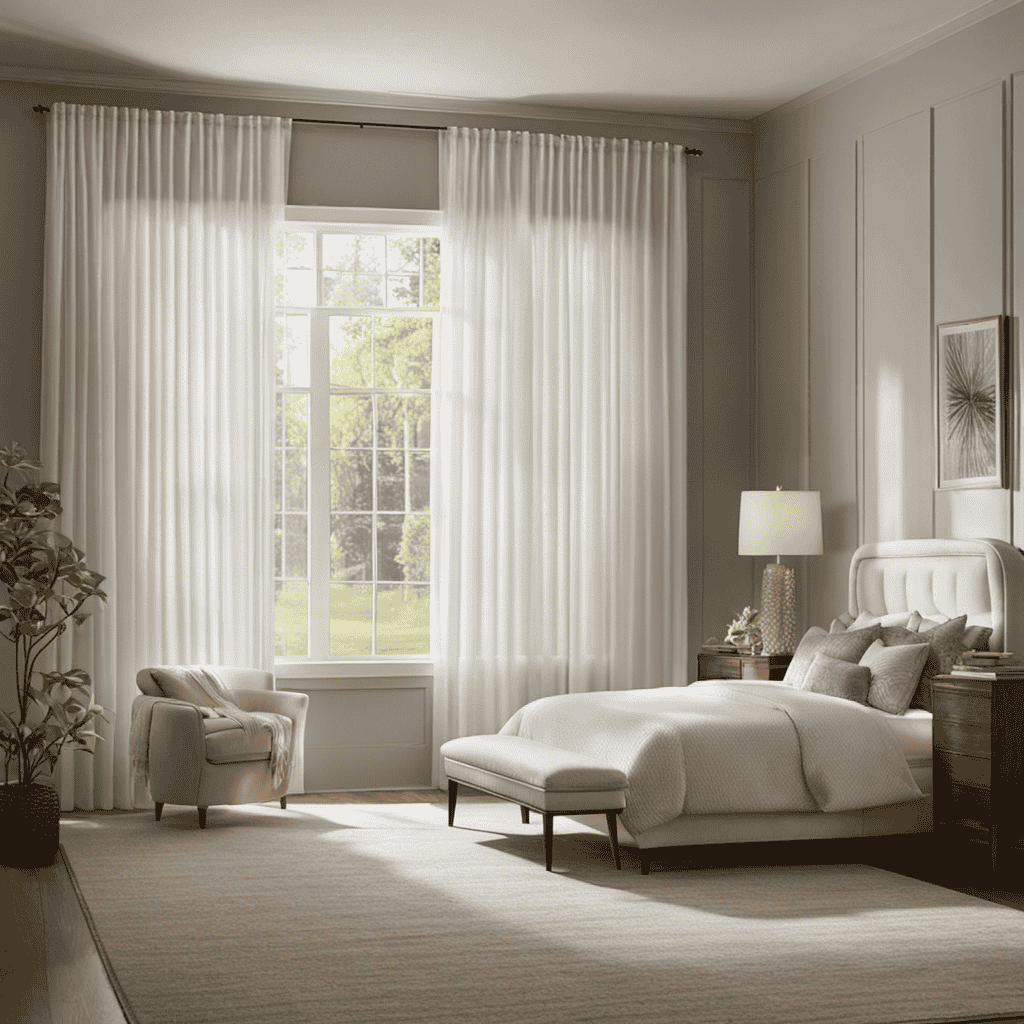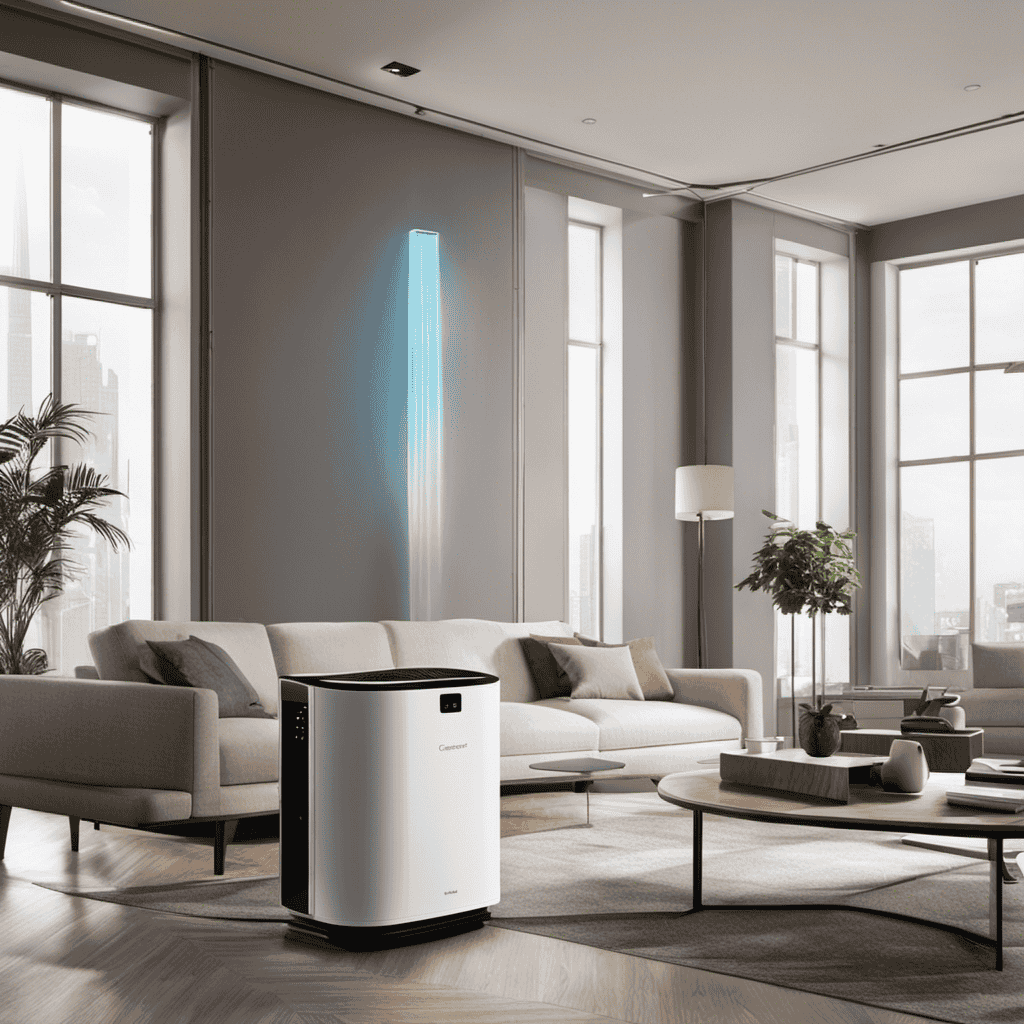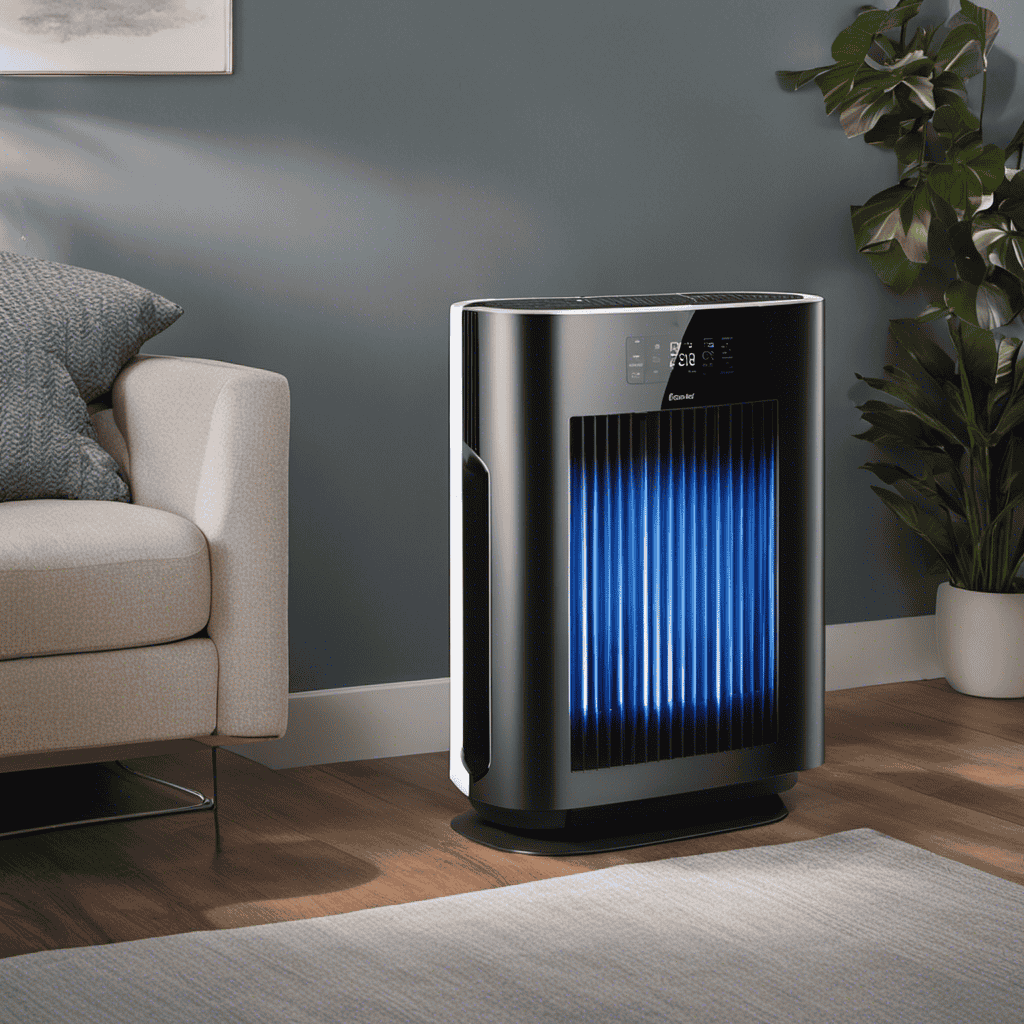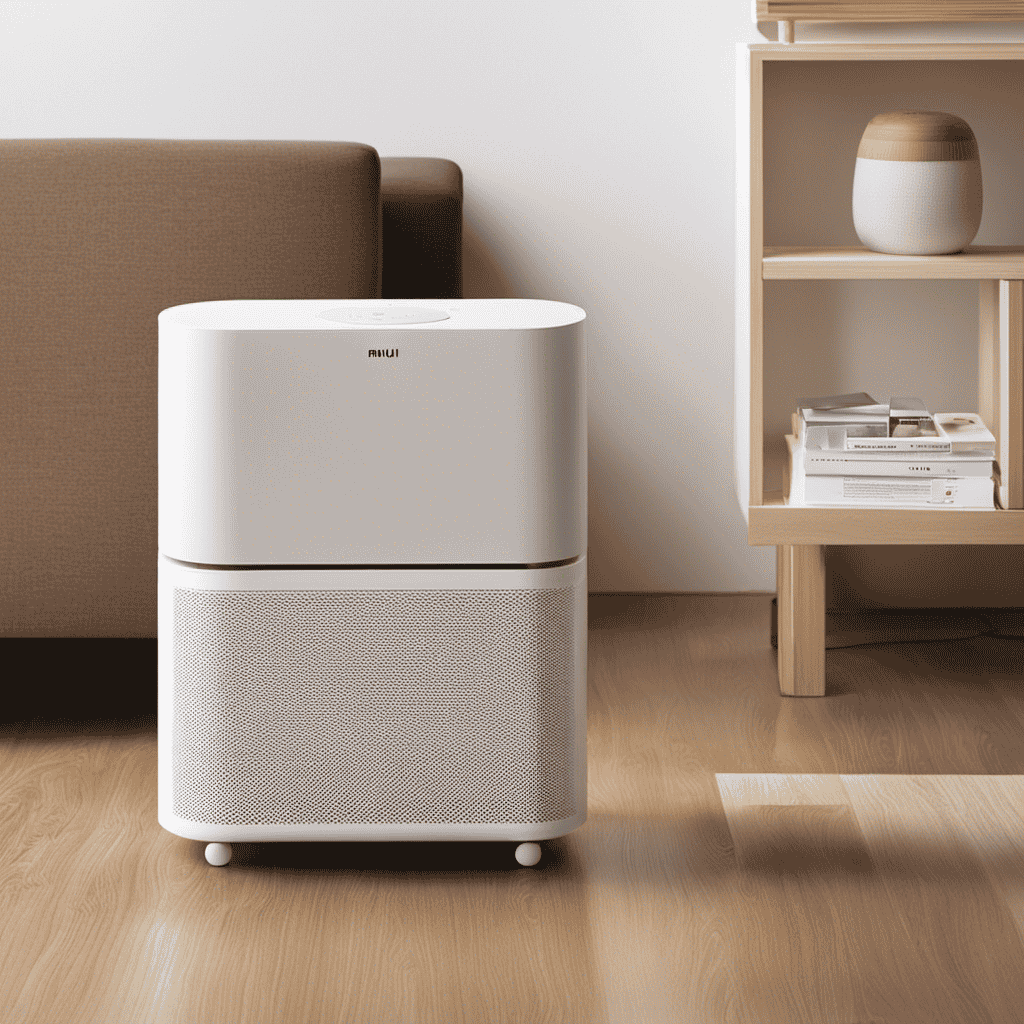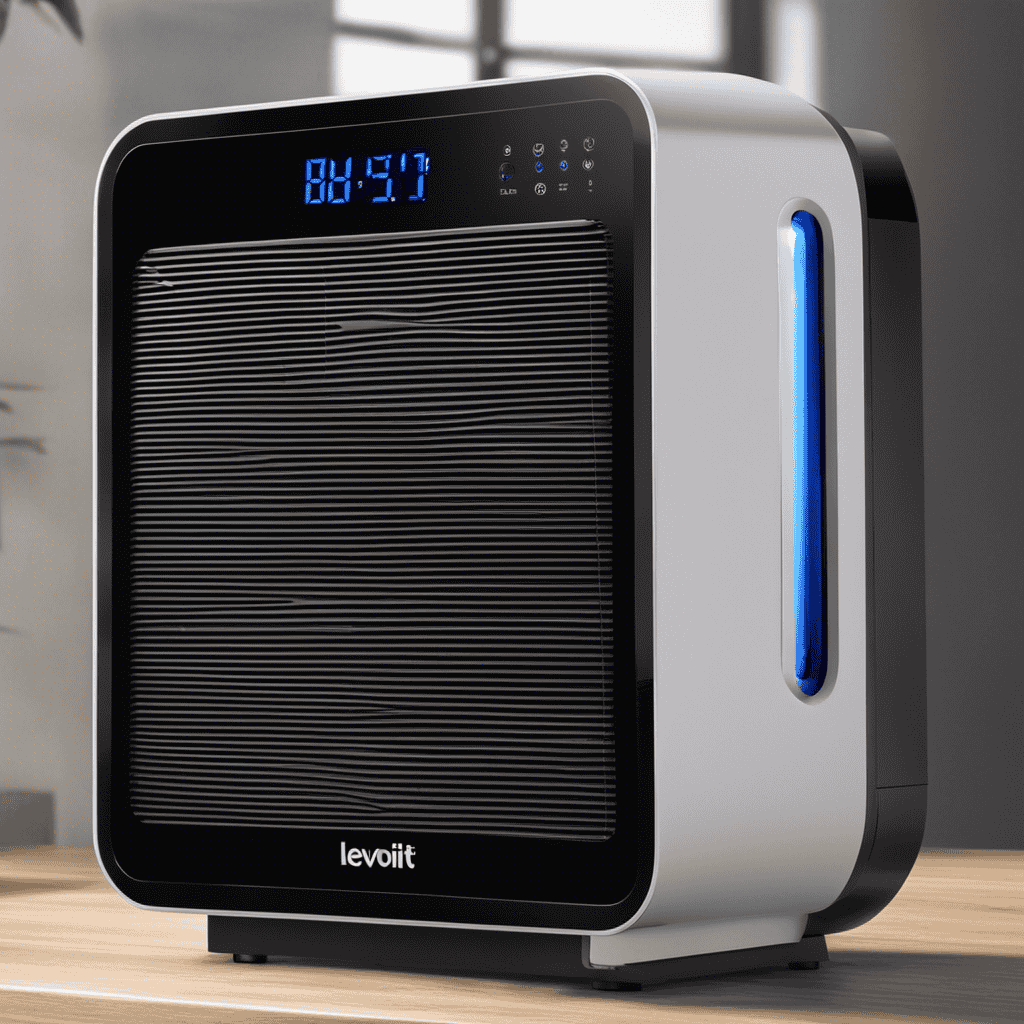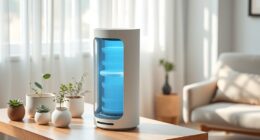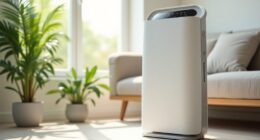As an individual with asthma, I am always looking for ways to enhance the air quality within my home. That is why I found it fascinating to discover the potential advantages of air purifiers in relieving asthma symptoms.
In this article, we will explore the relationship between asthma and indoor air quality, understand the triggers of asthma attacks, and discover how air purifiers can help.
By the end, you’ll have a clear understanding of the key features to look for in an air purifier and how it can be a valuable tool in managing your asthma.
Key Takeaways
- Indoor air quality is crucial for managing asthma and respiratory health.
- Asthma triggers such as allergies, dust mites, pet dander, and mold can worsen symptoms.
- Air purifiers can effectively remove airborne triggers and improve indoor air quality.
- Regular maintenance and proper filter cleaning or replacement are important for optimal air purifier performance.
The Relationship Between Asthma and Indoor Air Quality
If you have asthma, you’ll be interested to know about the relationship between your condition and the quality of the air inside your home. Indoor air quality plays a crucial role in asthma management and maintaining respiratory health. Poor air quality can trigger asthma symptoms and worsen respiratory function.
Asthma is a chronic respiratory condition characterized by inflammation and narrowing of the airways. People with asthma are highly sensitive to various triggers, including allergens and irritants present in the air. These triggers can lead to asthma attacks, causing coughing, wheezing, chest tightness, and shortness of breath.
Indoor air pollutants such as dust mites, pet dander, mold spores, and volatile organic compounds (VOCs) can act as triggers for asthma symptoms. These pollutants are commonly found in homes and can contribute to poor indoor air quality. Inadequate ventilation, smoking, and the use of certain household products can also worsen the air quality indoors.
To improve asthma management and respiratory health, it is crucial to address indoor air quality. Using air purifiers with high-efficiency particulate air (HEPA) filters can help remove allergens and pollutants from the air, reducing asthma triggers. Additionally, proper ventilation, regular cleaning, and minimizing exposure to irritants can further enhance the quality of the air indoors.
Understanding the Triggers of Asthma Attacks
Understanding the triggers can help individuals with asthma attacks better manage their condition. Asthma triggers are factors that can cause asthma symptoms or even a full-blown attack. By identifying and avoiding these triggers, individuals with asthma can reduce the frequency and severity of their symptoms.
One common trigger for asthma attacks is allergies. Allergies occur when the immune system overreacts to certain substances, such as pollen, dust mites, pet dander, or mold. When individuals with asthma are exposed to these allergens, it can lead to inflammation and constriction of the airways, resulting in difficulty breathing and other asthma symptoms.
To better understand asthma triggers and the role of allergies in asthma attacks, take a look at the following table:
| Asthma Trigger | Common Allergens | Other Factors |
|---|---|---|
| Pollen | Trees, grasses, weeds | High pollen count |
| Dust Mites | Dust, bedding, upholstered furniture | Humidity, lack of dust mite covers |
| Pet Dander | Cats, dogs, rodents | Pet ownership |
| Mold | Damp areas, outdoor molds | Poor ventilation, water leaks |
How Air Purifiers Can Help Alleviate Asthma Symptoms
When it comes to managing my asthma symptoms, I’ve found that air purifiers can be incredibly effective.
Not only do they help to remove airborne triggers such as dust, pollen, and pet dander, but they also improve air quality by reducing indoor pollutants.
Research has shown that using air purifiers can lead to a significant reduction in asthma symptoms, including wheezing, coughing, and shortness of breath.
Air Purifier Effectiveness
You can improve the effectiveness of air purifiers by regularly cleaning or replacing the filters. This is important because dirty filters can become clogged with particles and reduce the purifier’s ability to clean the air.
Here are three reasons why keeping your air purifier’s filters clean is essential:
-
Enhanced Air Quality: Clean filters allow air purifiers to effectively capture and remove allergens, dust, and pollutants from the air. This helps improve indoor air quality and reduces the risk of respiratory issues.
-
Prolonged Lifespan: Regularly cleaning or replacing filters can extend the lifespan of your air purifier. Clogged filters can strain the motor, leading to decreased performance and potential damage over time.
-
Optimal Performance: Clean filters ensure that air purifiers operate at their highest efficiency levels. By maintaining optimal performance, you can maximize the effectiveness of your air purifier in removing harmful contaminants from the air.
When it comes to air purifier technology, different brands offer various features and innovations. It’s important to research and choose a reputable brand that aligns with your specific needs and budget.
Asthma Symptom Relief
Regularly cleaning or replacing filters in your air purifier can help alleviate symptoms of asthma. Asthma triggers such as dust mites, pollen, pet dander, and mold spores can be effectively filtered out by a high-quality air purifier. By removing these triggers from the air, individuals with asthma can experience reduced symptoms and improved overall lung function. Managing asthma is crucial for maintaining a good quality of life, and using an air purifier is just one piece of the puzzle. It is important to identify other triggers in your environment and take steps to minimize exposure. This could include keeping your home clean, using hypoallergenic bedding, and avoiding smoking or exposure to secondhand smoke. By implementing a comprehensive asthma management plan that includes regular air purifier maintenance, individuals with asthma can find relief and improve their respiratory health.
| Asthma Trigger | Effect on Asthma Symptoms | Tips for Minimizing Exposure |
|---|---|---|
| Dust mites | Can cause wheezing, coughing, and chest tightness | Use allergen-proof covers on pillows and mattresses, wash bedding regularly in hot water |
| Pollen | Can trigger allergic reactions and aggravate asthma | Keep windows closed during high pollen seasons, limit outdoor activities |
| Pet dander | Can cause allergic reactions and worsen asthma symptoms | Keep pets out of bedrooms and off furniture, vacuum and dust regularly |
| Mold spores | Can trigger asthma attacks and respiratory symptoms | Keep humidity levels low in your home, repair any leaks or water damage |
Key Features to Look for in an Air Purifier for Asthma
One important feature to look for in an air purifier for asthma is a HEPA filter. These filters are designed to trap and remove small particles from the air, including allergens like dust mites, pollen, and pet dander. They are highly effective at improving indoor air quality and reducing asthma symptoms.
In addition to a HEPA filter, there are a few other key features to consider when choosing an air purifier for asthma:
-
Activated Carbon Filter: This type of filter is effective at removing odors, chemicals, and volatile organic compounds (VOCs) from the air. These substances can trigger asthma symptoms in some individuals, so having an activated carbon filter can provide an added level of protection.
-
Air Change Rate: The air change rate refers to how many times the air purifier can clean the air in a room per hour. For individuals with asthma, it is recommended to choose an air purifier with a high air change rate to ensure that the air is constantly being filtered and pollutants are being removed.
-
Size and Coverage Area: It is important to choose an air purifier that is suitable for the size of the room where it will be used. Consider the square footage and choose an air purifier that can effectively cover that area. This will ensure that the air is properly filtered and asthma triggers are minimized.
Choosing the Right Type of Air Purifier for Asthma Relief
When choosing the right type of air purifier for asthma relief, it’s essential to consider the specific needs and triggers of the individual. Different air purifiers offer different benefits, and understanding these benefits can help in making an informed decision.
To provide a visual representation of ideas, here is a table comparing different air purifier brands and their key features:
| Air Purifier Brand | Key Features |
|---|---|
| Brand A | HEPA filter, activated carbon filter, ozone-free |
| Brand B | True HEPA filter, UV-C light, smart sensor |
| Brand C | Electrostatic precipitator, ionizer, washable filter |
| Brand D | HEPA filter, carbon filter, quiet operation |
Each brand offers unique features that can help in alleviating asthma symptoms. For example, an air purifier with a HEPA filter can effectively remove allergens and pollutants from the air. Activated carbon filters can help eliminate odors and chemicals. UV-C lights can kill bacteria and viruses. Electrostatic precipitators can trap small particles, while ionizers can help freshen the air.
Tips for Proper Placement and Maintenance of Air Purifiers
To ensure effective performance and longevity, it’s important to properly place and maintain your air purifier. Here are three tips for proper placement and maintenance of air purifiers:
-
Choose the right location: Place your air purifier in the room where you spend the most time. This could be your bedroom, living room, or home office. Make sure it is placed away from walls, furniture, and other objects that may obstruct the airflow. The ideal placement is in the center of the room, allowing the air purifier to circulate the air effectively.
-
Regularly clean and replace filters: Proper maintenance of your air purifier includes cleaning or replacing the filters as recommended by the manufacturer. Over time, filters can become clogged with particles and lose their effectiveness. Regularly cleaning or replacing the filters will ensure that your air purifier continues to remove allergens and pollutants from the air.
-
Keep the surrounding area clean: Dust and other particles can accumulate around your air purifier, affecting its performance. Regularly dust and vacuum the area around the air purifier to prevent the build-up of dirt and debris. This will help maintain the efficiency of your air purifier and improve the quality of the air in your space.
Other Strategies to Improve Indoor Air Quality for Asthma Management
If you’re looking for additional ways to improve the quality of your indoor air for better asthma management, consider using natural cleaning products. These products are a great alternative to traditional cleaning chemicals, which can release harmful toxins into the air and worsen asthma symptoms. Natural cleaning products are made from ingredients like vinegar, baking soda, and essential oils, which are non-toxic and safe for both people and the environment.
In addition to using natural cleaning products, improving ventilation in your home is another effective strategy for enhancing indoor air quality. Proper ventilation helps to remove pollutants and allergens from the air, reducing the risk of asthma attacks. Opening windows and using exhaust fans can help to circulate fresh air throughout your home and prevent the buildup of harmful particles.
To provide a visual representation of these ideas, here is a table summarizing the benefits of using natural cleaning products and improving ventilation:
| Natural Cleaning Products | Improving Ventilation |
|---|---|
| Non-toxic and safe | Removes pollutants |
| Environmentally friendly | Circulates fresh air |
| Reduces asthma triggers | Prevents particle buildup |
How Do Air Purifiers Specifically Help with Asthma?
Air purifiers specifically designed for asthma relief can help by removing airborne triggers such as dust, pet dander, and pollen. These triggers can exacerbate asthma symptoms, but air purifiers with HEPA filters can capture and neutralize them, providing cleaner air for asthma sufferers to breathe more easily.
Frequently Asked Questions
Are Air Purifiers a Cure for Asthma?
Air purifiers effectiveness vary depending on the individual and their specific asthma symptoms. While they can help filter out allergens and improve air quality, they are not a cure for asthma.
It is important to remember that there is no one-size-fits-all solution for asthma treatment. Other alternative treatments, such as medication, inhalers, and avoiding triggers, should be considered in conjunction with using air purifiers to manage asthma symptoms effectively.
Can Air Purifiers Completely Eliminate Asthma Symptoms?
Air purifiers are a popular choice for improving indoor air quality. They can effectively remove pollutants like dust, pollen, and pet dander, which can trigger asthma symptoms. However, it’s important to note that air purifiers alone cannot completely eliminate asthma symptoms.
While they can provide short-term relief by reducing exposure to triggers, long-term benefits require a comprehensive asthma management plan. It’s crucial to work with healthcare professionals to develop a personalized approach that includes medication, environmental control, and proper ventilation alongside air purifier usage.
How Often Should I Replace the Filters in an Air Purifier?
When it comes to air purifier maintenance, one important aspect to consider is the regular replacement of filters. This ensures that the air purifier continues to function effectively in removing pollutants from the air.
Best practices for air purifier filters suggest replacing them every 3 to 6 months, depending on usage and the manufacturer’s recommendations. Regularly replacing filters helps maintain the efficiency of the air purifier and ensures cleaner air in your space.
Can Air Purifiers Remove All Asthma Triggers From the Air?
Can air purifiers remove all asthma triggers from the air?
Well, it’s important to understand that air purifier effectiveness can vary depending on the specific model and the type of asthma trigger.
While air purifiers can help reduce common asthma triggers like dust mites, pet dander, and pollen, they may not eliminate all triggers completely.
It’s always best to combine the use of an air purifier with other asthma management strategies, such as regular cleaning and minimizing exposure to triggers.
Are There Any Side Effects of Using Air Purifiers for Asthma Relief?
I’ve been researching the potential side effects of using air purifiers for asthma relief. It’s important to consider the effectiveness of these devices in reducing asthma symptoms.
Additionally, comparing different types of air purifiers can provide valuable insights into their efficacy for asthma relief.
Conclusion
In conclusion, air purifiers can be a game-changer for asthma sufferers. They are like a breath of fresh air, helping to alleviate symptoms and improve indoor air quality.
By targeting and removing asthma triggers, these devices provide much-needed relief. When choosing an air purifier, be sure to look for key features that are specifically designed for asthma management.
With proper placement and maintenance, these purifiers can be a valuable tool in your asthma management arsenal. So why not give your lungs a break and invest in an air purifier for a breath of relief?
